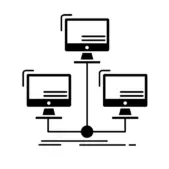Enterprise applications play a critical role in the success of modern organizations. Moreover, their impact extends far beyond just improving business operations and efficiency. Enterprise applications can also significantly influence employee retention, which is a key factor in an organization’s long-term success.
Although it may not receive as much attention as product innovation or quality customer service, employee retention is just as critical to an organization’s growth as any other facet of business. In this article, we will discuss how enterprise applications can help lead to improved organizational retention.

The Domino Effect of Employee Turnover
Retention is important largely because attrition can lead to a company-wide domino effect. When employees depart, they often leave with a unique skill set specific to the company. When employees have spent years specializing in your brand’s operations and processes, losing them can be incredibly costly. Decision-makers are forced to spend time and money in the recruiting process. This may include vetting candidates, conducting interviews, and evaluating various assessments.
When employees depart, their unique skill set leaves them, making the role extremely difficult to replace. During the hiring process, the departed employee’s responsibilities either halt or get passed to another worker. However, this other employee may lack the necessary expertise. After hiring a replacement, it typically takes months for them to reach the productivity level of the previous employee.
The impact of turnover costs at least twice an employee’s salary to onboard and train a replacement. Millennials, who now make up most of the American workforce, are known to switch jobs routinely. Furthermore, 83% of Gen Z employees also consider themselves to hop jobs frequently. Retaining these younger workers will be crucial moving forward to avoid unnecessary expenses and productivity loss.
Pushing Millennials Out the Door
Research has repeatedly shown that many Millennials greatly emphasize their employers’ technical savvy. After all, this generation of workers grew up in the Internet age, with mobile phones in their pockets and tablets on their laps.
This crop of workers has little patience for systems that don’t work properly. Additionally, they do not tolerate systems with sub-par communication and collaboration features and functionality. Using enterprise applications is one of the most effective tools to ensure these challenges don’t arise in the workplace.
Enterprise Applications to the Rescue
Enterprise applications, when properly developed and leveraged, help organizations improve processes and streamline operations in a number of ways.
For instance, the application can serve as a central location for various departments to share information. If your organization’s marketing, sales, finance, and customer service divisions can easily share consumer information using one application instead of three or four disparate systems, you can significantly reduce organizational complexity.
Enterprise applications offer numerous other advantages, including:
Cost Reduction
In addition to removing unnecessary complexity, robust enterprise applications enable employees to share information and collaborate in one location. They streamline workflows and eliminate redundant systems. This lowers overhead by removing the need for numerous systems and improving the bottom line.
It Builds Culture
One of the most difficult challenges contemporary businesses face is how to foster a sense of community across divisions. An enterprise application can help build a culture of togetherness by improving collaboration on essential projects.
UX Improvement
One of the benefits of reducing complexity through enterprise applications is that it makes life more convenient for employees. By providing a centralized platform for information sharing and collaboration, enterprise apps eliminate the need to toggle between multiple systems and applications. This streamlined user experience leads to greater employee satisfaction and engagement. Workers can focus on their core responsibilities rather than being bogged down by administrative and technical hurdles.
Investing in intuitive and user-friendly enterprise applications can be a significant competitive advantage for companies looking to attract and retain top talent, especially among younger generations.
Boosts Productivity
Enterprise applications also boost employee productivity. They streamline workflows, automate repetitive tasks, and provide real-time access to critical information. This empowers workers to focus on high-value activities and make faster, more informed decisions.

Getting the Most Out of Enterprise Applications
Like any other technology-based tool, enterprise applications can do more harm than good if not properly developed and implemented. For instance, if the application is difficult for some employees to use, they may become frustrated and abandon it altogether. Similarly, if only some workers use the tool while others do not, it can lead to a breakdown in communication and collaboration.
To avoid these pitfalls, it’s critical that the enterprise application be designed with the company’s specific needs in mind. A tool that includes numerous features that employees don’t need or want will add unnecessary complexity to daily operations instead of streamlining them.
Before beginning the development process, organizations should conduct thorough user research to understand exactly what their employees want and need from the enterprise application. This will help ensure seamless adoption and usage once the tool is rolled out. By aligning the application’s functionality with employee requirements from the start, companies can maximize the benefits and minimize the downsides of implementing new enterprise-wide software.
Ensuring Effective Enterprise Applications With UpTop
Business leaders cannot ignore the millennial engagement crisis impacting their bottom line. To resolve the problem, you’ve got to understand how your employees work and what they expect from the enterprise UX tools provided.
If you’re ready to tackle the workplace engagement crisis head-on, contact UpTop to learn how our enterprise UX services can help you build technology that inspires and empowers your workforce. Ready to improve employee engagement, productivity, and profits? Let’s chat.


